PLA vs PETG: Which Material Should You Choose?
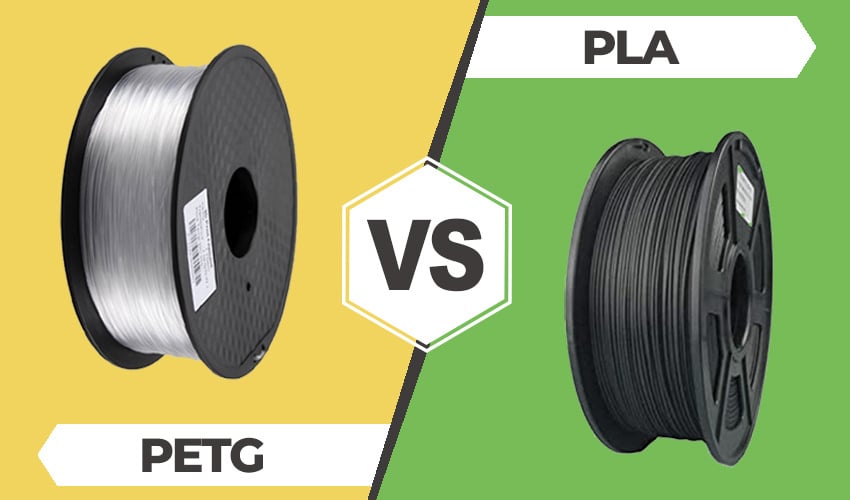
When most people think about 3D printing, the material that comes to mind is usually plastics. Though there are, of course, other materials, including metal and ceramic, polymers still make up the majority of the market for 3D printing materials. This is because they can be used not just for industrial applications, like prototyping, but they are also often the material of choice for desktop printers, especially those using fused deposition modeling (FDM) processes. Out of various materials, one of the biggest popularity competitions is undoutedly PLA vs PETG.
Known for ease of printing, these two materials are made into filaments that can be used by both beginners and experts with FDM printers. Though they are similar in several key ways, there are still significant differences between the two filaments. So what are the characteristics of the materials? How do they differ? When would you use one over the other? We took a closer look at both PLA vs PETG, comparing them to help you find the answers to these important questions and more!
Characteristics of PLA vs PETG
One of the major differences between PLA and PETG is of course how the two materials are made. PLA is known for being made out of renewable and natural raw materials like corn. It is also biodegradable under the correct conditions, making it a popular choice for those who are looking for sustainable, environmentally-friendly materials.
On the other hand, PETG is famously made out of PET, a well known thermoplastic. In order to create PETG, glycol (G) is added to PET (Polyethylene terephthalate) at the molecular level. PETG has a greater strength and durability and most importantly for 3D printing it is more flexible than PET, preventing it from becoming brittle when printed. Though PETG is 100% recyclable, it is an oil-based polymer meaning it is not biodegradable like PLA as it is not made out of raw materials.
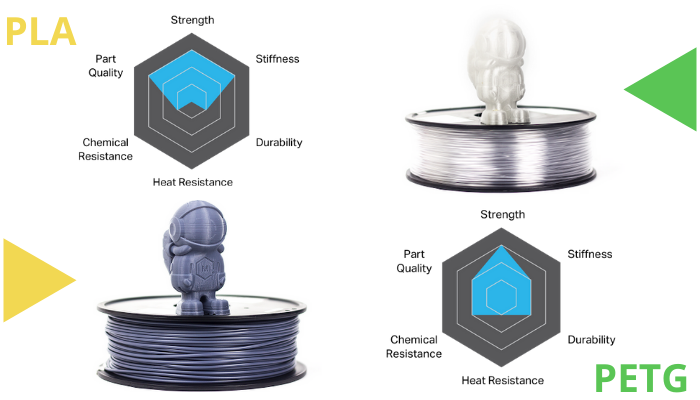
Physical Properties of PLA (left) vs PETG (right).
(Photo Credits: MatterHackers)
Ease of Printing
Moving beyond the base of the material,, there are definitely similarities between both polymers when it comes to technical characteristics. For example, they are both known for being easy to print with. In fact, PLA is one of the easiest, if not the easiest, materials to print with in 3D printing. This, understandably, has made it popular with beginners. Much of this comes down to heating, PLA can be printed at much lower temperatures and requires neither a heated printing bed nor a closed chamber. In terms of extrusion temperature, between 190-220℃ (374-428℉), is ideal for PLA, which is less than for PETG.
PETG is also considered one of the easier materials to print with, though less than PLA. A major part of that is that PETG also does not need a closed chamber. However, due to higher temperature requirements, a heated printing bed is required for PETG, limiting perhaps the choice of printers for some users. PETG generally prints at a higher temperature than PLA, with an extrusion temperature between 220° and 260°C necessary for optimal printing. Additionally, the Heating Bed Temperature should be between 75-90 °C.
One thing to note however, is that while it can be difficult initially to start printing with PETG (unlike PLA which can be printed with extreme ease from the get go), once you have the correct settings PETG is also known for being an easily extruded material with good thermal stability. Another thing to consider for both materials is that as they are high viscosity materials, they can clog printer heads. However, this is the case with many other plastics and should not necessarily be taken as a mark against either material.
Properties
If you are looking for a material with good physical properties, then it would be better to go with PETG over PLA. Unlike PLA, PETG is water-, chemically- and fatigue-resistant. It is also more durable than PLA as well as less stiff. Generally, PETG is seen as a mixture between ABS and PLA. That means, it takes the best qualities of both to a certain degree.
For example, PETG is stronger than PLA (though weaker than ABS) and more flexible than ABS (though less flexible than PLA). This, understandably, makes it a popular material as the short-comings of both materials are lessened within PETG. PETG is also known for being more rigid than PLA which also has its own benefits, notably in industrial applications. PETG is more durable over time, though many users note that it is extremely easy to scratch.
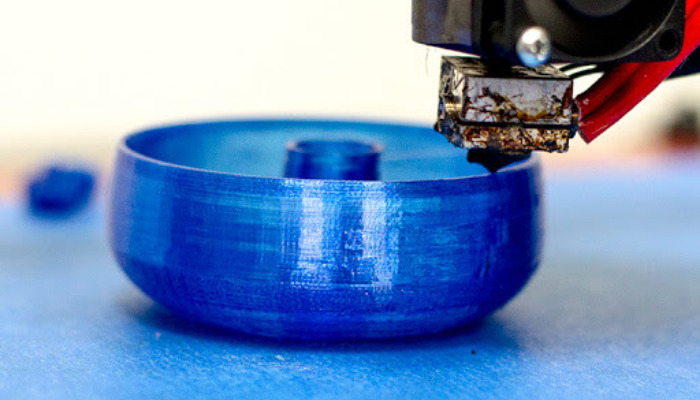
Printing a part with PLA (photo credits: MatterHackers)
Something to keep in mind is that PETG is often reinforced with carbon fiber, making it even stronger though more expensive. Of course, PLA can also be reinforced with carbon fiber, though it will be weaker than the PETG version due to the properties of both polymers. Additionally it has been noted that PETG is good for producing parts that are flexible but still resistant to shock. Neither PETG nor PLA is known for being UV resistant, though PETG is known for having a higher heat and UV resistance than PLA, meaning it can be exposed to the elements more than PLA before starting to break down.
PETG and PLA are both known to be non-toxic and generally odorless (PLA can produce a slightly sweet smell due to its nature), especially when compared to a plastic like ABS which can be quite harmful to the health of the user. That being said, it is still uncertain for many materials whether they extrude toxic fumes or not, PLA and PETG have not been found to be toxic, though you should always practice caution just in case. Additionally, both PETG and PLA are both less prone to warping than ABS, though the fact that PETG requires a heated bed suggests that the risk of warping is probably higher than it is for PLA.
Post-Processing
One important difference between PETG and PLA is ease of post-processing. In the case of PLA, there is a wider choice for post-processing and it is generally easier to do. In contrast, support structures can be difficult to remove when it comes to PETG due to the adhesion properties of the material. For support structures to be effective, there will need to be a small distance (at least a 0.5mm gap is recommended) between the support structures and the actual model, otherwise you risk damaging the structure of the printed part.
One post-processing process that works well with both however is sanding. Sanding can be used to smooth out the surface of a part, making it an especially important tool for those using FDM processes (what is used for both PETG and PLA filaments). Though it is said that sanding is slightly easier with PETG, making it useful for anyone wanting a glossy finish (something that PETG is also known for), it is not difficult to do with PLA. Plus with PLA you have more options.
An additional consideration, especially for those hoping to use printed parts as decoration or props, is that PLA can be painted while PETG cannot. Though PETG is known for being able to be transparent which has its own benefits in a number of sectors, such as the food industry or in industrial applications.
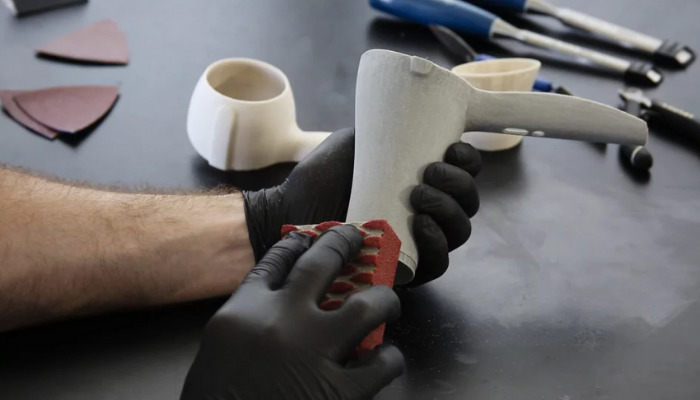
A 3D printed part being sanded (photo credits: MakerBot)
Applications for PLA vs PETG
There is significant overlap between applications for PLA and PETG, as might be expected for polymers with similar properties. They are both used in the food, medical, costume/prop making, decorative parts industries however each material proves its superiority in different ways.
For example, when thinking of PETG, the first application that should come to mind is the food industry. PET is the material that is used to make containers like plastic bottles thanks to its water resistance and durability. Not to mention, PET is what makes up 18% of worldwide global plastic production, showing that it is safe for contact with food. PETG has similar properties, additionally it is FDA approved. PETG’s water and higher resistance to heat makes it ideal for making parts that will come in contact with food, like tupperware.
PLA is also considered food-safe though to a lesser extent than PETG. For one, it can be less ideal for food industry applications just because unlike PETG is not resistant to water, though the degree to which it is food safe has also been called into question in recent years and users must ensure that they use PLA that does not have other additives.
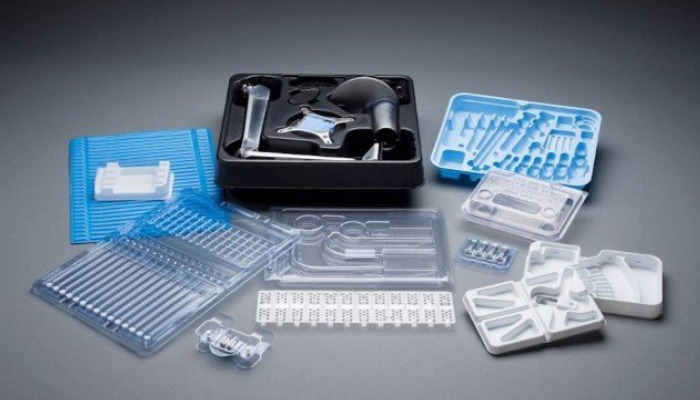
PETG can be used for a variety of applications including in the food industry. (Photo Credits: AMFG)
Additionally, both materials are used in the medical sector, though in slightly different capacities. PETG can withstand sterilization, making it a good material for medical implants and also pharmaceutical and medical device packaging. PLA is also popular in the medical sector, thanks to its biodegradable nature, it can be used for implants that are expected to biodegrade over time. Or, for example, it could be used for parts which need to release medicine over time in the body.
Overall, PETG is more suitable for parts that require higher heat and force than PLA thanks to its impressive physical properties. That being said, PLA is also often used for test and calibration items as well as dimensionally accurate assemblies, as it is better for projects that are detailed and able to be post-processed. However, neither are particularly industrial as they will break up over time unlike high-performance thermoplastic polymers like PEKK and PEEK.
PLA is a better choice vs PETG where aesthetics are concerned. As previously mentioned, PLA can be painted and can be shaped much more easily than PETG. Thanks to the fact that support structures are easy to remove, more complex, detailed pieces can be printed, making it perfect especially for decorative parts and cosplay props. It is also available in more colors than PETG, famously known for being a transparent material. Additionally, one particularly interesting feature of PLA is that it is often used to mimic other materials. It can be used to make hybrid filaments where PLA is mixed with other materials. For example, BronzeFill from colorFabb, Polishable Stainless Steel from Proto-Pasta, PolyWood from Polymaker, or marble PLA filament come to mind. However, both are used in this industry as they both make attractive parts.
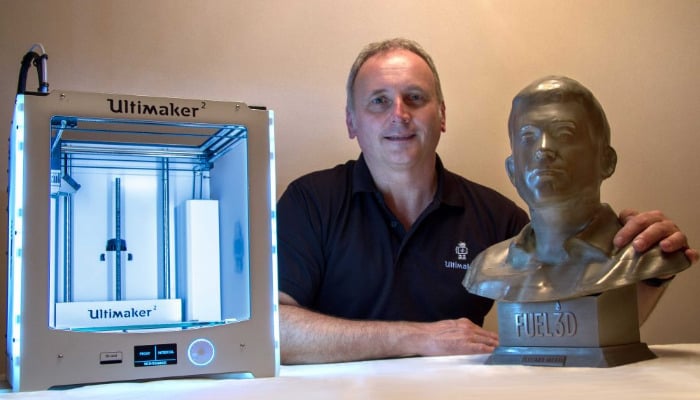
A bust made using colorFabb’s Bronzefill filament (photo credits: colorFabb)
Price
Though it is often thought that PLA is significantly cheaper than PETG, that is not necessarily the case. For example, it is possible to find low-range PLA for around $18 for a 1kg spool while you can find low range PETG for around 20 dollars for 1 kg of spool from manufacturers or resellers, however PETG tends to have a more fixed price than PLA. Although you can find PLA for cheaper than PETG, it is not uncommon for manufacturers/resellers to have their low range PLA priced higher than their low range PETG. In terms of high range materials, both could be priced at over a hundred dollars. Something to keep in mind with both materials is that what causes the price to vary is the quality of the filament, both materials can vary drastically in quality from low quality filament just for hobbyists to material that can be used semi-industrially. Also, any PLA or PETG filaments with added materials, like carbon fiber, will be more expensive. When looking for filament, it is a good idea to look at the major manufacturers and compare prices based on your specific needs.
Manufacturers
Most manufacturers offering PLA filaments will also offer PETG filaments. As two of the most basic available filaments for 3D printing, it would be a surprise for any major supplier not to have at least one of the two. Out of our list of suppliers, many of them are the major suppliers for filaments in general. This of course is another benefit for those who are new to 3D printing or those who want to use a specific kind of filament, thanks to the breadth of manufacturers, it will be a lot easier to find the price and characteristics you need for a filament. Even though the list we have included is not exhaustive (the entire list could probably be several articles entirely by itself), we just want to highlight some of the main suppliers for the market.
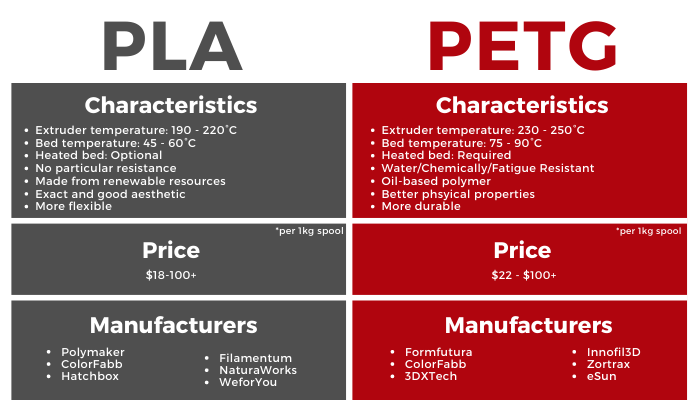
Credits: 3Dnatives
What do you think of PETG vs PLA? Is there one material you prefer over the other? Let us know in a comment below or on our Linkedin, Facebook and Twitter pages! Sign up for our free weekly Newsletter here, the latest 3D printing news straight to your inbox! You can also find all our videos on our YouTube channel.







While PLA is biodegradable, it is not because it is biobased. In fact, some of the most reliable biodegradable polymers are petroleum based. PBAT (poly-butylene adipate teraphthelate) is probably the most notable biodegradable polymer, and it is petroleum based. With that said, PLA could be considered a renewable resource, or more sustainable than PETG because it can be broken down (albeit at high temperatures ~75°C) and utilized by microbes.
I’d like to see what data you used to determine that PLA is simultaneously less rigid and durable than PETG and weaker. I understand that PLA creeps more under load, but that wasn’t discussed either. From studies and independent testing that I’ve read (you may have seen studies that say the opposite, but I’ve yet to stumble upon any), PLA has greater compressive and tensile strength than PETG and ABS. It is also more rigid than both of these thermoplastics, hence its tendency to stress-fracture under load rather than bend. In this article, there was no mention of PETG hygroscopy compared to PLA; instead, it was asserted that PETG is more water-resistant than PLA, which—when printed—is true, but it feels disingenuous to fail to compare hygroscopic tendencies of the polymers. Overall, this article reads well, but the “information” provided is highly misleading, inaccurate, and seems thrown together from a series of similar pieces written by equally clueless authors.
I should add that PLA being weaker than PETG and ABS is a common misconception propagated through the 3D printing community since 3D printers became accessible to the masses (i.e., early RepRap era). I’m unsure whether it’s a misunderstanding of these filaments’ properties or the abundance and widespread acceptance in the early adoption of ABS during this advent that led to this misconception. But the myth needs to die.
Here’s an excellent study to get you started: https://www.mdpi.com/2073-4352/11/8/995/
Hi i would like to know if PETG and PLA will lose its ESD protection after machining?